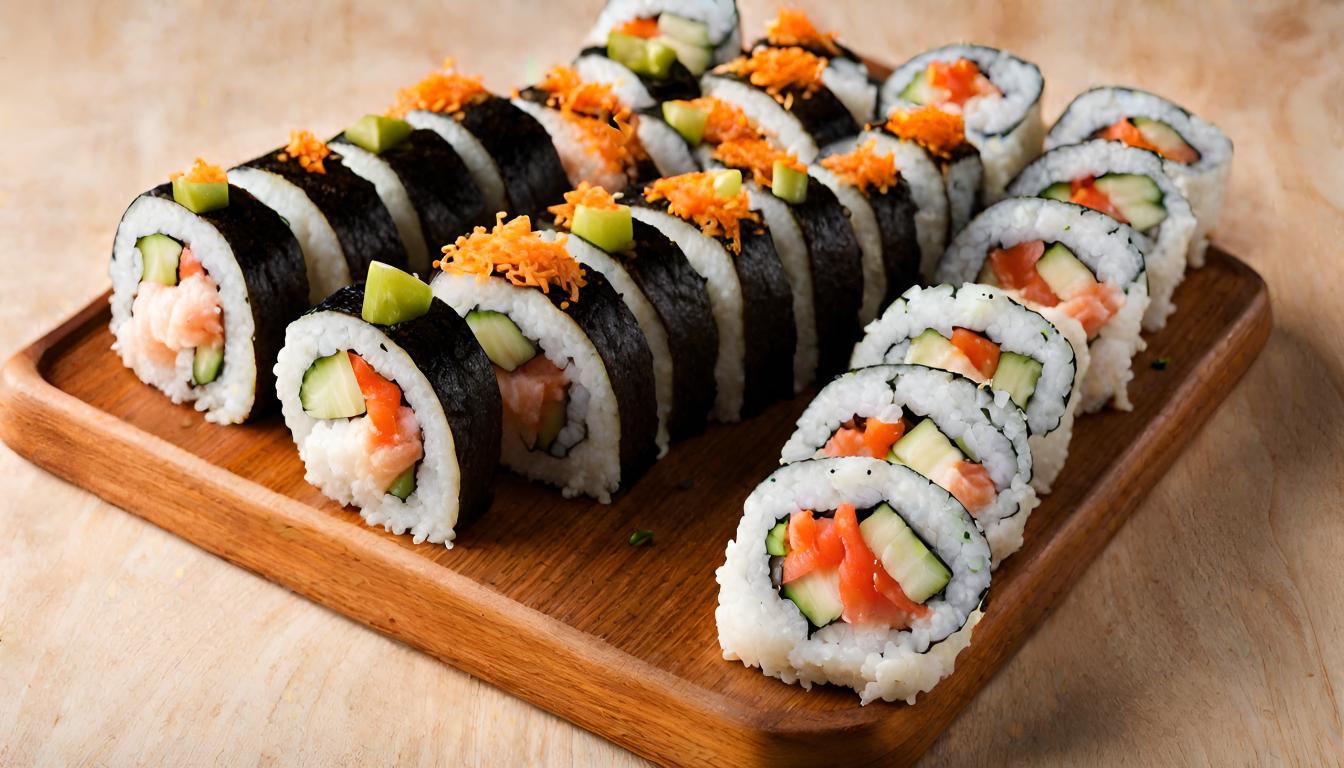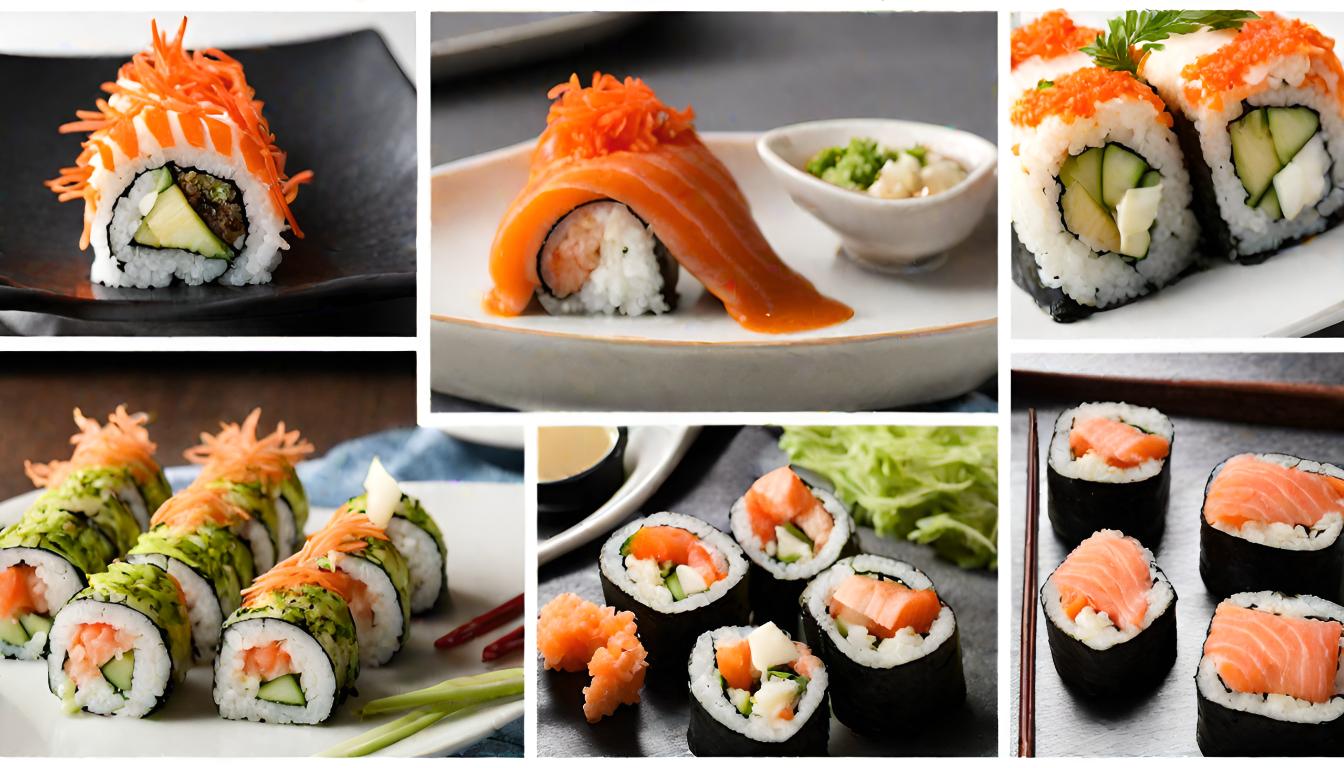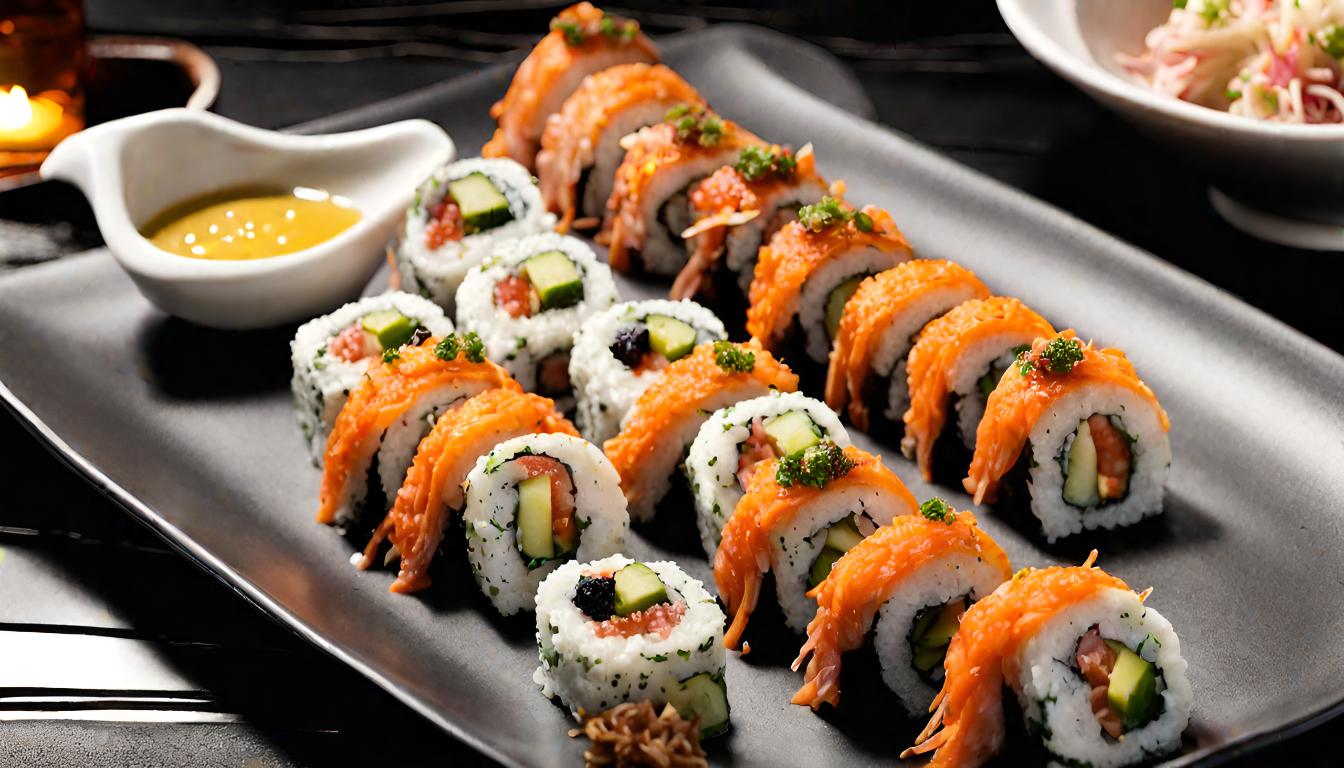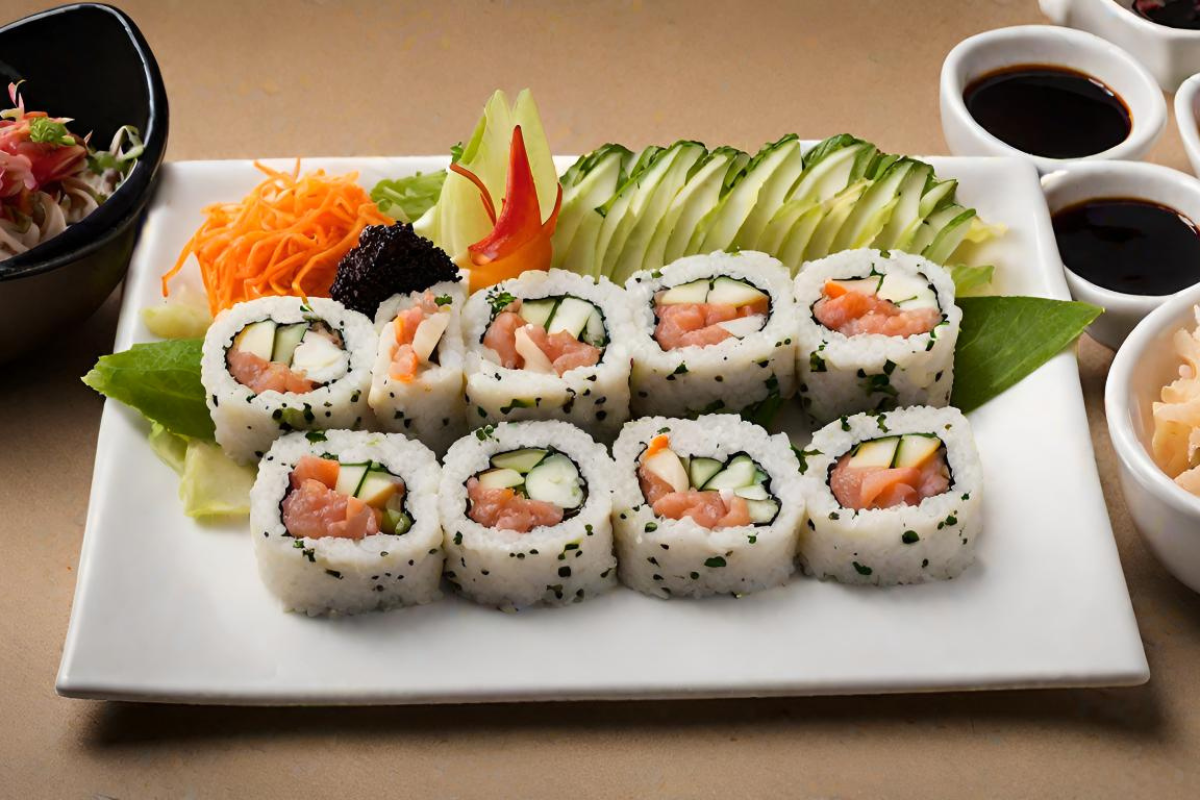Embark on a culinary journey into the world of the Alaska Roll, a delightful sushi creation that blends traditional Japanese techniques with unique flavors. This article will explore the history, preparation, and variations of the Alaska Roll, offering a comprehensive guide for sushi enthusiasts and culinary explorers.
Introduction to Alaska Roll
Exploring the Delights of Alaska Roll
The Alaska Roll, a sushi variant, has gained popularity for its unique blend of flavors. It’s not just a dish; it’s a culinary experience that combines tradition with innovation.
A Fusion of Flavors in Sushi Cuisine
The Alaska Roll stands out in the sushi world. It typically features a mix of fresh salmon, creamy avocado, and sometimes crab, wrapped in a seaweed sheet and rice. This combination of ingredients creates a delightful balance of flavors and textures, making the Alaska Roll a favorite among sushi lovers.
The Rising Popularity of Alaska Roll
In recent years, the Alaska Roll has become a staple in many sushi restaurants worldwide. Its appeal lies in its simplicity and the subtle interplay of flavors, which can vary slightly depending on the chef’s interpretation. This sushi roll has become a symbol of how traditional sushi can evolve to embrace new tastes and preferences.
In the next part, we’ll delve into the historical background of the Alaska Roll, tracing its origins and understanding its place in the evolution of sushi cuisine.
Stay tuned as we explore the rich history of the Alaska Roll, uncovering its origins and cultural significance. Whether you’re a seasoned sushi aficionado or just starting to explore this culinary art, this journey through the history of the Alaska Roll is sure to be both enlightening and appetizing. For mastering sushi-making techniques, Sushi Making Guide offers a wealth of knowledge and tips.
Continuing our exploration of the Alaska Roll, we now delve into its historical background, uncovering the origins and cultural significance of this unique sushi variant.
Part 2: Historical Background
The Origins of Alaska Roll
The Alaska Roll’s story is a fascinating blend of culinary innovation and cultural adaptation, reflecting the dynamic nature of sushi cuisine.
From Traditional to Modern Sushi
While the exact origins of the Alaska Roll are somewhat unclear, it’s believed to be a Western adaptation of traditional Japanese sushi. The roll combines elements of Japanese sushi-making with ingredients popular in Western cuisine, like salmon and avocado. This fusion reflects the adaptability of sushi to different tastes and cultures.
Cultural Significance in Japanese Cuisine
In Japanese cuisine, sushi is more than just food; it’s an art form. The introduction of rolls like the Alaska Roll showcases the global influence on this culinary art and how it has evolved to appeal to a broader audience. The Alaska Roll, in particular, represents a meeting point between traditional Japanese techniques and Western culinary preferences.
In the next part, we’ll explore the traditional recipe for the Alaska Roll, including the essential ingredients and the step-by-step process to create this delightful sushi dish
Stay tuned as we share the secrets of preparing the classic Alaska Roll. Whether you’re an experienced sushi chef or a home cook looking to try something new, our upcoming section will guide you through creating this delicious and visually appealing sushi roll. For more insights into incorporating sushi into a healthy diet, Healthy Eating Tips is a helpful resource.

Traditional Alaska Roll Recipe
Crafting the Classic Alaska Roll
The Alaska Roll, known for its fresh and flavorful combination, is a delightful sushi variant that you can prepare at home. Let’s explore the traditional recipe for this popular sushi roll.
Essential Ingredients and Their Roles
To make an authentic Alaska Roll, you’ll need:
- Rice: Sushi rice, seasoned with a mix of rice vinegar, sugar, and salt, forms the base.
- Nori Sheets: These seaweed sheets hold the roll together.
- Filling: Fresh salmon, avocado, and sometimes crab or crab imitation are the key fillings.
- Optional Toppings: Sesame seeds or tobiko (flying fish roe) for garnishing.
Step-by-Step Preparation Guide
- Prepare the Sushi Rice: Cook the sushi rice and season it with the vinegar mixture. Let it cool to room temperature.
- Slice the Fillings: Cut the salmon and avocado into thin slices.
- Assemble the Roll: Place a nori sheet on a bamboo mat, spread a layer of rice, and arrange the salmon and avocado slices on top.
- Rolling: Carefully roll the sushi using the bamboo mat, applying even pressure to form a tight roll.
- Cutting: With a sharp knife, cut the roll into bite-sized pieces.
- Serve: Arrange the sushi pieces on a plate and garnish with sesame seeds or tobiko.
In the next part, we’ll explore modern variations of the Alaska Roll. From fusion recipes to creative adaptations, we’ll see how this traditional sushi roll can be transformed to suit various tastes and dietary preferences.

Stay tuned as we delve into contemporary twists on the traditional Alaska Roll. Whether you’re looking to experiment with new flavors or adapt the recipe to dietary needs, our upcoming section will provide a range of creative and delicious ideas. For exploring global sushi variations, World Cuisine Recipes offers a diverse collection to inspire your sushi-making adventures.
Modern Variations
Contemporary Twists on Alaska Roll
The Alaska Roll, while deeply rooted in sushi tradition, lends itself beautifully to modern interpretations and creative culinary twists.
Fusion Recipes and Global Influences
- Global Flavors: Chefs are reimagining the Alaska Roll. They infuse global flavors. Imagine adding Sriracha or teriyaki sauce. Some recipes include cream cheese or mango. These ingredients offer a new taste experience.
- Creative Combinations: Some modern recipes play with the inclusion of unique ingredients like cream cheese, cucumber, or even tropical fruits like mango, adding a new dimension to the traditional flavor profile.
Vegetarian and Vegan Adaptations
- Vegetarian Alaska Roll: For a vegetarian version, you can replace the salmon with tofu or an assortment of vegetables like bell peppers and carrots. This adaptation maintains the essence of the Alaska Roll while catering to vegetarian preferences.
- Vegan Variants: Vegan sushi lovers can enjoy Alaska Rolls made with plant-based alternatives like avocado, cucumber, and vegan cream cheese, ensuring that the roll is entirely free from animal products.
In the next part, we’ll delve into the nutritional information of the Alaska Roll. We’ll explore its health benefits, dietary considerations, and ways to balance flavor with health.

Nutritional Information
Nutritional Profile of Alaska Roll
The Alaska Roll is nutritious but should be enjoyed in moderation. It contains omega-3 fatty acids and healthy fats. Consider the overall calorie content. Balance your meal with vegetables.
Health Benefits and Dietary Considerations
The Alaska Roll, primarily made with salmon and avocado, offers nutritional benefits such as omega-3 fatty acids from the salmon and healthy fats from the avocado. However, it’s important to consider the overall calorie and carbohydrate content, mainly due to the sushi rice. Moderation is key, especially for those monitoring their carbohydrate intake.
Tips for a Balanced Meal
For a healthier version of the Alaska Roll:
- Opt for Brown Rice: Using brown rice instead of white sushi rice can increase the fiber content and lower the glycemic index.
- Control Portion Sizes: Be mindful of serving sizes to manage calorie intake effectively.
- Balance with Vegetables: Accompany your Alaska Roll with a side of fresh vegetables or a light salad to add nutritional value.
In the next part, we’ll explore serving and pairing suggestions for the Alaska Roll. From ideal accompaniments to presentation tips, we’ll provide ideas to enhance your Alaska Roll experience.
Stay tuned as we delve into creative ways to serve and enjoy the Alaska Roll. Whether you’re hosting a sushi night or enjoying a family meal, our upcoming section will inspire you to present this classic sushi roll in the most appealing and delicious way. For those seeking additional insights into balancing flavor and health in sushi, Healthy Eating Tips is a helpful resource.
Serving and Pairing Suggestions
Enhancing Your Alaska Roll Experience
Serve the Alaska Roll with complementary sides. Edamame, miso soup, or seaweed salad are great choices. Offer soy sauce, wasabi, and pickled ginger. Arrange the rolls neatly on a platter. Garnish with sesame seeds or avocado slices.
Ideal Accompaniments and Pairings
- With Complementary Sides: Pair the Alaska Roll with sides like edamame, miso soup, or a seaweed salad. These sides add a refreshing contrast and complete the sushi dining experience.
- Soy Sauce, Wasabi, and Ginger: Offer traditional sushi condiments like soy sauce for dipping, wasabi for a spicy kick, and pickled ginger as a palate cleanser.
Presentation and Serving Tips
- Plating Techniques: Serve the Alaska Roll on a simple, elegant sushi platter. Arrange the rolls neatly and garnish with a sprinkle of sesame seeds or a few slices of avocado for added visual appeal.
- Family Style: For family or group settings, consider a sushi spread featuring Alaska Rolls along with other sushi varieties, allowing everyone to enjoy a range of flavors.
In the next part, we’ll address some of the most common questions about the Sushi Roll . From preparation tips to storage advice, we’ll provide answers to the queries that enthusiasts of this sushi roll frequently ask.
Stay tuned as we delve into the FAQs section, where we’ll clear up any uncertainties and offer helpful insights to ensure your Sushi Roll experience is as enjoyable as possible. Whether you’re a first-time sushi maker or a seasoned pro, this section will have something for everyone! For more culinary tips and pairing suggestions, World Cuisine Recipes offers a wide range of ideas and insights.

Answering Common Questions About Alaska Roll
Let’s dive into some of the most common queries about this beloved sushi roll.
- Can You Make Alaska Roll Without Raw Fish?
- Yes, you can make an Sushi Roll without raw fish. Some variations use smoked salmon or even cooked seafood as alternatives, making it suitable for those who prefer not to eat raw fish.
- How Do You Keep Alaska Rolls Fresh?
- To keep Sushi Roll fresh, wrap them tightly in plastic wrap and store them in the refrigerator. They are best consumed within 24 hours to maintain their quality and flavor.
- What Are Some Common Mistakes When Making Alaska Rolls?
- Common mistakes include overfilling the roll, which can make it difficult to roll, and using too much or too little rice. Achieving the right balance is key for the perfect roll.
- Are Alaska Rolls Healthy?
- Sushi Roll can be a healthy option, especially when made with fresh ingredients like salmon and avocado. However, be mindful of the rice portion to keep the carbohydrate content in check.
- Can Alaska Rolls Be Made in Advance?
- While it’s best to enjoy sushi rolls fresh, you can make Sushi Roll a few hours in advance. Keep them refrigerated until serving to preserve their freshness.
In the final part of our article, we’ll wrap up with some concluding thoughts on the enduring charm of the Sushi Roll . We’ll recap the key points and leave you with some final reflections on this sushi delight.
Conclusion
The Enduring Charm of Alaska Roll
The Sushi Roll is more than just a sushi item; it’s a culinary delight that showcases the fusion of traditional Japanese techniques with contemporary flavors.
Recap and Final Thoughts
- A Culinary Staple: The Sushi Roll , with its combination of fresh salmon, creamy avocado, and sometimes crab, has established itself as a favorite in the world of sushi, enjoyed by enthusiasts and casual diners alike.
- Versatile and Adaptable: This sushi roll not only honors the tradition of Japanese sushi-making but also embraces innovation, allowing for various adaptations and modern twists that cater to diverse tastes and dietary preferences.
- A Dish for All Occasions: Whether it’s a special dinner, a casual gathering, or a solo treat, the Alaska Roll brings joy and sophistication to any meal.
In closing, the Sushi Roll is not just a meal; it’s an experience, a journey through the flavors and art of sushi making. Whether you stick to the traditional recipe or experiment with new variations, this sushi roll is sure to bring a touch of elegance and satisfaction to your culinary adventures.
As we reach the conclusion of our exploration into the world of the Sushi Roll , let’s take a moment to reflect on the unique charm and appeal of this beloved sushi variant.
Conclusion
The Enduring Charm of Alaska Roll
The Sushi Roll is more than just a sushi item; it’s a culinary delight that showcases the fusion of traditional Japanese techniques with contemporary flavors.
Recap and Final Thoughts
- A Culinary Staple: The Sushi Roll , with its combination of fresh salmon, creamy avocado, and sometimes crab, has established itself as a favorite in the world of sushi, enjoyed by enthusiasts and casual diners alike.
- Versatile and Adaptable: This sushi roll not only honors the tradition of Japanese sushi-making but also embraces innovation, allowing for various adaptations and modern twists that cater to diverse tastes and dietary preferences.
- A Dish for All Occasions: Whether it’s a special dinner, a casual gathering, or a solo treat, the Alaska Roll brings joy and sophistication to any meal.
In closing, the Sushi Roll is not just a meal; it’s an experience, a journey through the flavors and art of sushi making. Whether you stick to the traditional recipe or experiment with new variations, this sushi roll is sure to bring a touch of elegance and satisfaction to your culinary adventures.
We hope this journey through the world of the Sushi Roll has inspired you to try making this delightful sushi roll in your own kitchen. Remember, cooking is not just about following a recipe; it’s about bringing a piece of culinary art to your table and creating memories that last a lifetime. So go ahead, give the Sushi Roll a try, and savor the rich flavors and textures of this exquisite sushi creation. For more insights into sushi cooking and recipes, World Cuisine Recipes is a wonderful resource to explore.

